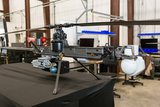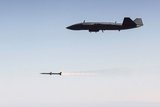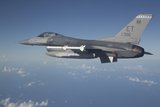USAF spends big on airborne AEHF terminals
A USAF RC-135 Rivet Joint lands at RAF Mildenhall on 18 April 2019. (Photo: USAF/Airman 1st Class Joseph Barron)
Raytheon has received a ten-year, $960 million IDIQ contract from the USAF Nuclear Weapons Center to support Advanced Extremely High Frequency (AEHF) radiation-hardened SATCOM terminals aboard aircraft.
Services include interim contractor support, contractor logistics support, terminal depot activation, terminal hardware/software procurement and studies associated with support of AEHF terminals.
Raytheon provides protected AEHF terminals for the USAF, US Army and USN, with more than 500 systems in service.
The company obtained a $442.3 million contract in mid-January 2020 under the Force Element Terminal (FET) programme, to install AEHF terminals aboard USAF B-52 strategic bombers and RC-135 Rivet Joint reconnaissance aircraft.
Both aircraft types are switching from the Military Strategic Tactical Relay satellite constellation to AEHF.
More from Air Warfare
-
![Anduril UK and GKN Aerospace collaborate on British Army ACP bid]()
Anduril UK and GKN Aerospace collaborate on British Army ACP bid
The pair will submit their demonstrator concept for Project Nyx, a development project for the British Army’s Land Autonomous Collaborative Platform.
-
![US Army command’s Picatinny CLIK common lethal drone interface makes progress]()
US Army command’s Picatinny CLIK common lethal drone interface makes progress
The Picatinny Common Lethality Integration Kit is designed to overcome the issue of unique integration methods between lethal payloads and drones as well as avoiding problematic acquisition conditions created by vendor lock.
-
![Australia invests extra A$1.4 billion in MQ-28A Ghost Bat after successful missile fire test]()
Australia invests extra A$1.4 billion in MQ-28A Ghost Bat after successful missile fire test
The investment includes new contracts for six MQ-28A Ghost Bat aircraft, as well as provisional funds to invest in the development of a Block 3 prototype.
-
![US approves potential $4.7 billion missile and air defence system sales to Denmark and Italy]()
US approves potential $4.7 billion missile and air defence system sales to Denmark and Italy
Italy could field the JASSM-ER for its combat aircraft including the F-35, while Denmark has been approved for AMRAAM and an Integrated Battle Command system procurement.
-
![Northrop Grumman to fly new Project Talon CCA by late 2026]()
Northrop Grumman to fly new Project Talon CCA by late 2026
The newly unveiled collaborative combat aircraft looks to strike a balance between capability and cost-effectiveness, according to the company.
-
![MBDA and Lockheed move closer to F-35A Meteor flight tests]()
MBDA and Lockheed move closer to F-35A Meteor flight tests
Following the completion of successful ground tests, one more exercise remains before flight testing can begin.
























